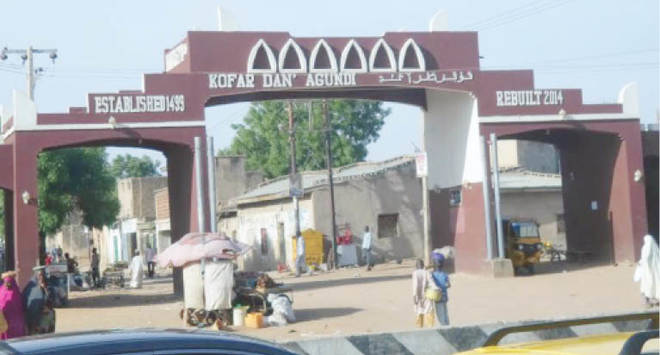
The Kano city wall built 1, 000 years ago, and its numerous gates are national monuments but both the ancient and modern city gates, such as the ones in Kaduna and Abuja have seen changes in fortunes over the years. Our correspondent who travelled to Kano, Kaduna and Abuja delves into the history of city gates and reports
Many ancient cities in Northern Nigeria are dotted with city gates. Cities like Sokoto, Katsina, Zazzau among many other big and even smaller emirates and chiefdoms are not left out. In Hausa they are called kofa, which translates as doors.
One of the earliest constructed is Kano’s Kofar Dan Agundi built in 1499. It was reconstructed in 2014.
Even with intercity wars long relegated to history books, the tradition of building city gates apparently has come to stay. The modern variants are decorative, ceremonial or commemorative.
They are mostly used to receive dignitaries and on occasions, souvenir keys are presented to important personalities as a mark of honour.
The Kaduna city gate for instance was built when Queen Elizabeth II, the reigning Queen of England and then Head of Government of Nigeria, visited the city in 1956. The construction was done by the Northern Regional Government.
Similarly, the Abuja city gate was built in 1991 to commemorate the relocation of Nigeria’s seat of government from the old capital of Lagos. It was erected as a temporary edifice to serve the purpose of a ceremonial pavilion, and to also symbolize the ceremonial entrance of government into its new capital. Plans to relocate the city gate to a more appropriate location later seemed to have been discarded.
The ancient city gates have been used as official places to receive dignitaries, wayfarers, merchants, farmers, herders, hunters among others. Gates keepers locked them in the evenings and opened them in the mornings during peace times. Such an official was called ‘Sarkin Kofa’ or lord of the gate.
Over the years, the needs to lock the gates no longer existed and cities have often spilled beyond the walls and gates that bounded them.
Around Dan Agundi Gate, traces of the Sarkin Kofa have disappeared. There is no house or tent for him, as there used to be before. Now the gates are surrounded by artisans, traders, mechanics among others for who the areas around the gate provide a good business environment.
However, the ancient Kano city gates were built over 1,000 years ago in the 11th century and have been rebuilt over the years to let in articulated vehicles and cars as opposed to the original camels, horses and humans that formed the traffic the first designers had in mind.
Construction of the walls started during the reign of King Gijimasu, who reigned from 1095 to 1135. As of today, Kano has 15 gates, namely: Kofar Dan Agundi, Kofar Nasarawa, Sabuwar Kofa, Kofar Na’isa, Kofar Gadankaya, Kofar Famfo, Kofar Dukawiya, Kofar Kabuga, Kofar Kansakali, Kofar Waika, Kofar Ruwa, Kofar Dawanau, Kofar Wambai, Kofar Mazugal and Kofar Mata.
However Sabuwar Kofa was built after the British invaded and conquered Kano in 1903, making it a colonial city gate. While Kofar Famfo was built during the time of Emir Abdullahi Bayero for people to fetch pipe borne water otherwise known as ‘famfo’ in Hausa language.
So significant are the walls that they have attained global recognition.
“Kano City walls and gates was declared as National Monument on 23rd April 1959,” Mr. Dipo Alafiatayo Deputy Director (Monument) in the National Commission for Museums and Monuments, NCMM said proudly.
In 2004, the German government renovated some of the city gates. In the same year, during the administration of former governor, Musa Kwankwaso, some of them were also rebuilt and renovated. A cultural group from Britain also visited Kano some years back and rebuilt some portions of the walls. However, some sections of the walls and gates are a thousand years old.
The Kaduna city gate has not enjoyed as much favours and has not been designated a national monument.
Alhaji Ali Sarkin Mota was the Chief Driver of the former Premier of the Northern Region and later became the driver of the Governor of North Central State, Brigadier Abba Kyari. He was the one who drove the Queen into Kaduna.
“The place was called Kaduna City Centre and the Queen was received at State House, Kawo just a stone throw from the City Centre.”
“She came from Kano to Kaduna by road,” recalls elder statesman Alhaji Abbas Sambo. “She was received at the Kaduna city gate, where two towers were erected and commissioned to commemorate her visit to Kaduna which was then the seat of Northern regional government.”
He thinks the gates should be accorded more prominence.
“The gates are still a mark of history for the coming generations. Kano is famous for having 12 city gates. The Kaduna city gate was built with white stones and concrete made from cement, was painted white, green and black, but suffered neglect for many years. No Nigerian like President Gowon, or a foreign dignitary was received there as a mark of respect for the Queen before and after independence,” he said.
Confirming this honour reserved for the queen, Alhaji Umar Mai Borno, an estate management consultant, recalled an incident from his youth during the visit of Emperor Haile Selassie.
“I was a pupil in 1972 at Sultan Bello Primary School in Unguwan Sarki Kaduna when we trekked from the school, I thought we would cheer him at the city gate where we were told he would be received by Sardauna. But we were later told to proceed to State House (renamed General Hassan Katsina House) Kawo to cheer the then visiting Emperor Haile Selassie of Ethiopia, who was not received at the city gate but was rather hosted to a luncheon by the then Head of State, General Yakubu Gowon, at the State House. Indeed only the Queen was received at the Kaduna city gate.”
About four years ago, the original tower was demolished to give way for the expansion and dualization of Kaduna city road during the administration of Governor Mukhtar Ramalan Yero. The towers were later re-erected by his successor.
Not many people know the significance of the city gate as many of the people conducting petty trading around the vicinity of the city gate admitted to.
The Abuja city gate on the other hand has had contrasting fortunes. In 2013, plans by President Goodluck Jonathan to erect a new city gate at Kuje Junction was met with protest over the N64bn price tag.
The new gate was expected to have been executed through Public Private Partnership and would have had different axis for different purposes. The Central axis would have pedestrian bridges; the Northern axis would have conference rooms, parade ground, botanical garden, five-star hotel and hospital among others. The Northern axis would also serve as a place where a new president would be given the key to enter the city.
For now, that project is too ambitious for Nigeria’s struggling economy. But perhaps in the future things might change.




